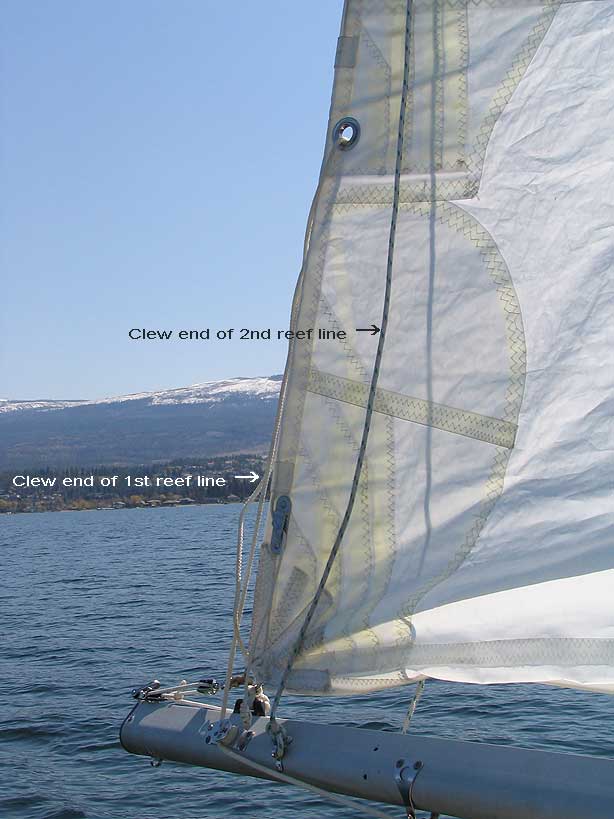
Single line reefing.
Headsail downhaul. (at the bottom of the page)
I have developed a simple system to help myself reef quickly and painlessly.
I certainly didn't create the system, for me the basic idea came out of an old Harken catalogue. Over time I discovered that Gary Hoyt is said to have invented this system many years ago.
I liked the Harken single line reefing
system but needed to do two sets and not have the lines run
down mast to the deck.
Another one of my requirements was not wanting to complicate taking off the
boom when taking down the rig for trailering or storage. This system here keeps
all the lines on the sail and boom. So if you just furl the sail to the boom
for storage, then lines are inclusive. If you prefer to take the sail off the
boom, you will have to deal with the reefing lines. When I take the rig down,
I leave the sail furled to the boom, slip the boom out of the mast and I am
ready to roll. I usually also roll the furled main/boom in the sail cover as
well.
The basic routing for the first reef line is:
From the clew end of the boom you will need a small pad eye on the port side of the boom. The placement of this pad eye is important as the cringle or eye will be drawn down this point. This location is determined by eyeballing a plumb line from the cringle down to the boom and then go aft about an inch or so. Each sail is different so the location of the pad eye will be different. I rivet all this hardware to the boom. If you have not done any rivet work before, no worries, it is really easy and inexpensive. A simple riveter tool and aluminum rivets in many sizes are sold at most hardware stores. Experiment on some scrap before you mess with your good boom and hardware. Try to make sure your rivets draw up nice and tight. If they dont....get them out (dremel/drill/cold chisel) and try again.
So your first reef line is fastened and starts at this pad eye port side, goes
up and through the cringle/eye/grommet and back down to a starboard side single
cheek block riveted to the boom directly lined up across from the pad eye on
the port side. Align this so the reef line pulls evenly across the boom.

This is the single cheeky block I use. Made by Racelite, sold by Duckworks.
Link
here.
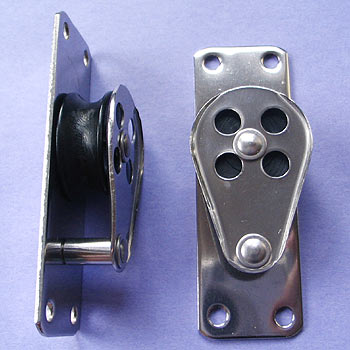
The line then turns at the cheek block, runs forward to a double cheek block mounted on the forward starboard end of the boom. The line then turns up through the outer sheave to a ring or block fasten to the first reef cringle and back down to the inner sheave on the double cheek block. The line turns aft to a clam cleat with a built in fairlead. The fairlead keeps the line from always disappearing on you. I believe this particular clam cleat I ended up using is a Ronstan item.
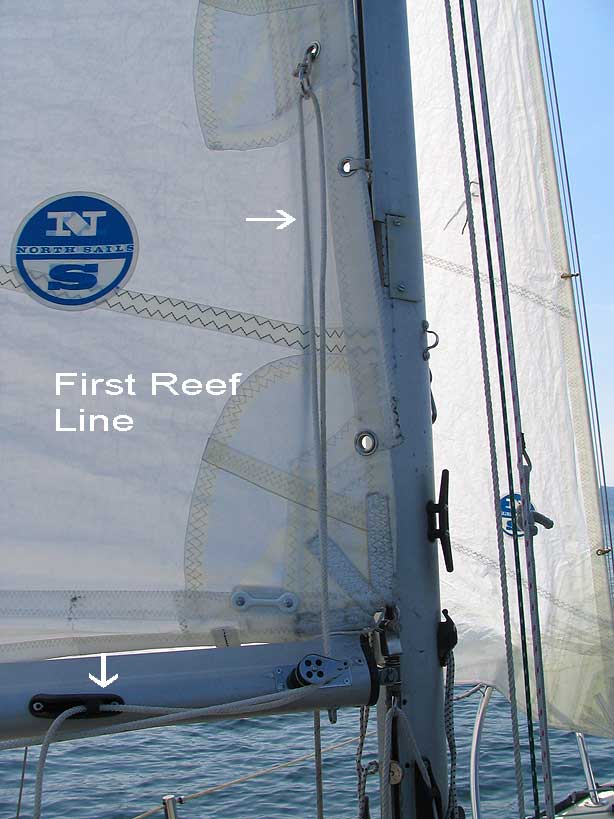
This slack line running the length of the boom is supported by a single small pad eye mid way along its length. I used a single supporting pad eye....but I think two would be better. The reason I used a pad eye for this rather than a fairlead is that a fairlead does not sit well on a arched surface and the pad eye can be bent to fit perfectly. Plus the pad eye gives me another place to clip something if I need to.
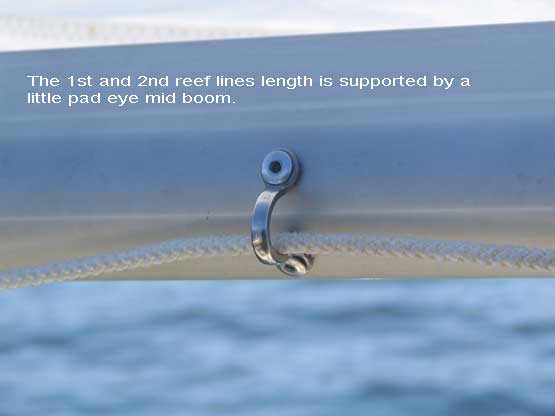
This is the double cheek block I use: Link here.
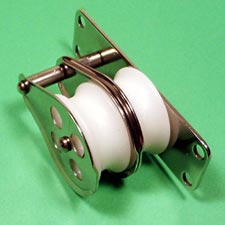
So that covers the single
line reef for the first reef. The second reef line is done the same way....but
a mirror image of the first reef.
To reef a single you are best to do that on a starboard tack
as the first reef line is mounted starboard side boom....easy to reach and get
at.
So when going down another reef it should be done on a port tack
as the reefing gear is on the port side.
The beauty of this
system is you can do the whole dance from the cockpit or while standing in the
companionway....providing you are not a short folk and providing topping lift
and main halyard controls are lead aft as well.
Once you have rigged all this stuff you will then need to mark your halyard
at the correct spot. Pre-locating the belay point on the halyard is a real time
saver and can be found no matter how much beer your mates make you consume.
So here's my step by step reefing process for the first reef:
~Put the boat on a starboard
tack. I often use a beam reach or while hove to. Either of these points of sail
would be determined if I reefed early or was caught with my pants down.
~Take up on the topping lift to support the aft end of the boom so it does not
clank you or your mates coconut....
~Slack off the main sheet so it is not under full tension with the sail drawing...
~Let out the halyard to the predetermined spot...
~Yank on the reefing line until the two cringles are down on the boom....
~Belay the reefing line at the clam cleat and secure the excess reefing line...
~Slack off the topping lift...
~Haul in the main sheet and trim the sail...
At this point you can be back to sailing and dealing with whatever needs dealing
with.
Once you have settled then tidy up the slack sail with your reefing
pendants. You will also need to tidy up the now slack line of your
second reefing line both to get it out of your way and to make it ready if needed.
Remember that your reefing pendant do not go around the boom....they
just bundle up slack sail. You can seriously damage the sail if you secure your
pendants around the boom. If you have a footed main (attached to the boom with
bolt rope slot) I would not use pendants at all. If you have a footed main with
slugs you could slip the pendants between boom and foot.
Depending on your point of sail, you may also need to tweak your clew outhaul
to tension the sail for proper trim.
I hope this helps someone. If it is not clear or you have any questions feel free to ask. tim@timtone.com
Have fun.
Tim Diebert
Kelowna BC (Canada)
Montgomery 17 #369 ....PUFF
My main websites:
www.timtone.com
www.timtone.com/portfolio.htm
While I was writing this page I discovered that Garry Hoyt has a page on his website that has a great explanation of his system. He even has a video of an automated single line reefing system on a large sailboat.
Where I sail I can get blind sided by sudden increases in wind strength from an entirely different quadrant. Reefing the mainsail in these conditions is usually not possible. Generally I am fending off and trying not to get knocked down or broken. One thing I can usually do very quickly, once I have a second is to dowse the headsail. I generally sail with a 155 genny so I can be overpowered quickly. I have rigged a simple no brainer downhaul on the headsail that I not only use just in urgent situations, but every time I dowse the sail. The best part is I can do this without going on the foredeck.
From the cockpit coaming
top starboard side forward....just where the coaming turns to the house sides....I
have a swivel cam cleat. I use 1/8" line that leads straight forward through
fairleads mounted on the life line stanchions to a small block attached at the
stem head fitting right next to the tack shackle. The line then turns an goes
to a small locking carabineer which is attached to the uppermost hank (I have
Winchard style hanks). I have enough room with these hanks to clip the carabineer
to the eye of the hank....the part that closes around the forestay.
Some folks run their downhaul line through the eyes of each hank. On my boat
at least....this does not work. It binds up and can be quite risky. My downhaul
line turns at the black and just flys up to where ever the upper hank happens
to be. It works very well and never binds.
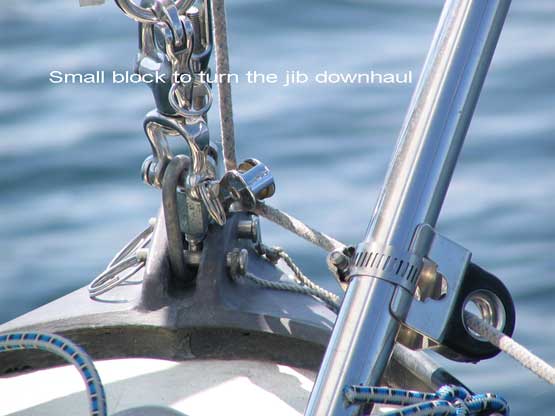
The procedure is:
~Make sure the sail is over the deck so that when it all comes down it does
not end up in the drink. Use the sheets to arrange this.
~Unclip the jib halyard with the left hand, hang on to it to keep some tension
in the line and haul on the downhaul with your right hand. Be sure your mate
is not directly behind your right arm as a black eye could be in the future.
Belay the downhaul at the cleat (important) and secure the jib halyard.
Budda bing....you are done.
Instant. It takes only seconds. Even if it is howling, as long as you have the
downhaul belayed and tension on the sheets the headsail won't go anywhere that
will effect the boat....unless the seas are big enough to bury the fordeck....then
you need to get that sail below.
I have found that if you are hit with a really big wind and you need to chill
before going back to sailing, take down the main, come around to a dead run,
then take the headsail off and stow it. An M17 will sail as peaceful as can
be stern to the wind and waves all by itself. This gives you a chance to wipe
up spilled beer and get yourself sorted for the next move or sail change.
In fact, I have sailed over three knots downwind with no sail at all on my M17.
That's what we call a 100% reef. ~:0)
Have fun!
Tim.